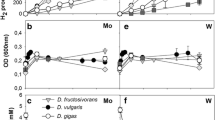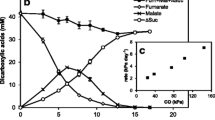Abstract
Thiosulfate was oxidized stoichiometrically to tetrathionate during growth on glucose byKlebsiella aerogenes, Bacillus globigii, B. megaterium, Pseudomonas putida, two strains each ofP. fluorescens andP. aeruginosa, and anAeromonas sp. A gram-negative, rod-shaped soil isolate, Pseudomonad Hw, converted thiosulfate to tetrathionate during growth on acetate. None of the organisms could use thiosulfate as sole energy source. The quantitative recovery of all the thiosulfate supplied to heterotrophic cultures either as tetrathionate alone or as tetrathionate and unused thiosulfate demonstrated that no oxidation to sulfate occurred with any of the strains tested. Two strains ofEscherichia coli did not oxidize thiosulfate. Thiosulfate oxidation in batch culture occurred at different stages of the growth cycle for different organisms:P. putida oxidized thiosulfate during lag and early exponential phase,K. aerogenes oxidized thiosulfate at all stages of growth, andB. megaterium andAeromonas oxidized thiosulfate during late exponential phase. The relative rates of oxidation byP. putida andK. aerogenes were apparently determined by different concentrations of thiosulfate oxidizing enzyme. Thiosulfate oxidation byP. aeruginosa grown in chemostat culture was inducible, since organisms pregrown on thiosulfate-containing media oxidized thiosulfate, but those pregrown on glucose only could not oxidize thiosulfate. Steady state growth yield ofP. aeruginosa in glucose-limited chemostat culture increased about 23% in the presence of 5–22 mM thiosulfate, with complete or partial concomitant oxidation to tetrathionate. The reasons for this stimulation are unclear. The results suggest that heterotrophic oxidation of thiosulfate to tetrathionate is widespread across several genera and may even stimulate bacterial growth in some organisms.
Similar content being viewed by others
References
Caldwell DE, Caldwell SJ, Tiedje JM (1979) An ecological study of the sulfur-oxidising bacteria from the littoral zone of a Michigan lake and sulfur spring in Florida. Plant and Soil 43:101–114
Friedrich G, Mitrenga G (1981) Oxidation of thiosulfate byParacoccus denitrificans and other hydrogen bacteria. FEMS Microbiol Lett 10:209–212
Hutchinson M, Johnstone KI, White D (1969) Taxonomy of the genus Thiobacillus: the outcome of the numerical taxonomy applied to the group as a whole. J Gen Microbiol 57: 397–410
Justin P, Kelly DP (1978) Growth kinetics ofThiobacillus denitrificans in anaerobic and aerobic chemostat culture. J Gen Microbiol 107:123–130
Kämpfe, Pfennig N (1980) Capacity of Chromatiaceae for chemotrophic growth. Specific respiration rates ofThiocystis violacea andChromatium vinosum. Arch Microbiol 127:125–137
Kelly DP, Chambers LA, Trudinger PA (1969) Cyanolysis and spectrophotometric estimation of trithionate in mixture with thiosulfate and tetrathionate. Anal Chem 41:898–901
Kelly DP, Kuenen JG (1984) Ecology of the colourless sulfur bacteria. In: Codd GA (ed) Aspects of microbial metabolism and ecology. Academic Press, London, pp 211–240
Kondratieva EN, Zhukov VG, Ivanovsky RN, Petushkova Yu P, Monsonov EZ (1966) The capacity of phototrophic sulfur bacteriumThiocapsa roseopersicina for chemosynthesis. Arch Microbiol 108:287–292
Kuenen JH, Beudeker RF (1982) Microbiology of thiobacilli and other sulfur oxidising autotrophs, mixotrophs and heterotrophs. Phil Trans R Soc London Ser B298:473–497
Kurek E (1979) Oxidation of inorganic sulfur compounds by yeast. Acta Microbiol Polon 28: 169–172
Kurek E (1983) An enzymatic complex active in sulfite and thiosulfate oxidation byRhodotorula sp. Arch Microbiol 134:143–147
Kurek E (1985a) Properties of an enzymatic complex active in sulfite and thiosulfate oxidation byRhodotorula sp. Arch Microbiol 143:277–282
Kurek E (1985b) Elemental sulfur and thiosulfate oxidation byRhodotorula sp. Zbl Mikrobiol 140:497–500
London J, Rittenburg SC (1966) Effects of organic matter on the growth ofThiobacillus intermedius. J Bacteriol 91:1062–1069
Lyric RM, Suzuki I (1970) Enzymes involved in the metabolism of thiosulfate byThiobacillus thioparus. III. Properties of thiosulfate-oxidising enzyme and proposed pathway of thiosulfate oxidation. Can J Biochem 48:355–363
Morris I, Glover HE, Kaplan WA, Kelly DP, Weightman AL (1985) Microbial activity in the Cariaco Trench. Microbios 42:133–144
Nelson DC, Castenholz RW (1981) Use of reduced sulfur compounds byBeggiatoa sp. J Bacteriol 147:140–154
Pepper IL, Miller RH (1977) Comparison of the oxidation of thiosulfate and elemental sulfur by two heterotrophic bacteria andThiobacillus thiooxidans. Soil Sci 126:9–13
Robertson LA, Kuenen JG (1982)Thiosphaera pantotropha gen. nov. sp. nov., a facultatively anaerobic, facultatively autotrophic sulfur bacterium. J Gen Microbiol 129:2847–2855
Schook LB, Berk RS (1978) Nutritional studies withPseudomonas aeruginosa grown on inorganic sulfur sources. J Bacteriol 133:1377–1382
Schook LB, Berk RS (1979) Partial purification and characterisation of thiosulfate oxidase fromPseudomonas aeruginosa. J Bacteriol 40:306–308
Silver M, Lundgren DG (1968) Sulfur-oxidizing enzyme ofFerrobacillus ferrooxidans (Thiobacillus ferrooxidans). Can J Biochem 46:457–461
Starkey RL (1934a) Isolation of some bacteria which oxidise thiosulfate. Soil Sci 39:197–219
Starkey RL (1934b) The production of polythionates from thiosulfate by microorganisms. J Bacteriol 28:387–400
Taylor BF, Hoare DS (1979) New facultativeThiobacillus and a reevaluation of the heterotrophic potential ofThiobacillus novellus. J Bacteriol 100:487–497
Trudinger PA (1961) Thiosulfate oxidation and cytochromes inThiobacillus X. 2. Thiosulfateoxidising enzyme. Biochem J 78:680–686
Trudinger PA (1967) Metabolism of thiosulfate and tetrathionate by heterotrophic bacteria from soil. J Bacteriol 93:550–559
Tuovinen OH, Kelly DP (1973) Studies on the growth ofThiobacillus ferrooxidans. Arch Mikrobiol 88:285–298
Tuttle JH (1980) Organic carbon utilization by resting cells of thiosulfate-oxidising marine heterotrophs. Appl Environ Microbiol 40:516–521
Tuttle JM, Jannasch HW (1972) Occurrence and types of thiobacillus-like bacteria in the sea. Limnol Oceanog 17:532–543
Tuttle JH, Jannasch HW (1973) Sulfide and thiosulfate-oxidising bacteria in anoxic marine basins. Marine Biol 20:64–70
Tuttle JH, Jannasch HW (1977) Thiosulfate stimulation of microbial dark assimilation of carbon dioxide in shallow marine waters. Microbial Ecol 4:9–25
Tuttle JH, Holmes PE, Jannasch HW (1974) Growth rate stimulation of marine pseudomonads by thiosulfate. Arch Microbiol 99:1–14
Tuttle JH, Schwartz JH, Whited GM (1983) Some properties of thiosulfate-oxidising-enzyme from marine heterotroph 16B. Appl Environ Microbiol 14b:438–445
Veinstein MB (1976) On taxonomy ofThiobacillus trautweinii. Mikrobiologiya (USSR) 45: 137–141
Vishniac W, Santer M (1957) The thiobacilli. Bacteriol Rev 21:195–213
Wainwright M (1984) Sulfur oxidation in soils. Adv Agron 37:349–396
Wainwright M, Nevell W, Grayston SJ (1986) Potential use of heterotrophic sulfur-oxidising microorganisms as soil inoculants. Sulfur in Agriculture 10:6–11
Author information
Authors and Affiliations
Rights and permissions
About this article
Cite this article
Mason, J., Kelly, D.P. Thiosulfate oxidation by obligately heterotrophic bacteria. Microb Ecol 15, 123–134 (1988). https://doi.org/10.1007/BF02011707
Issue Date:
DOI: https://doi.org/10.1007/BF02011707




